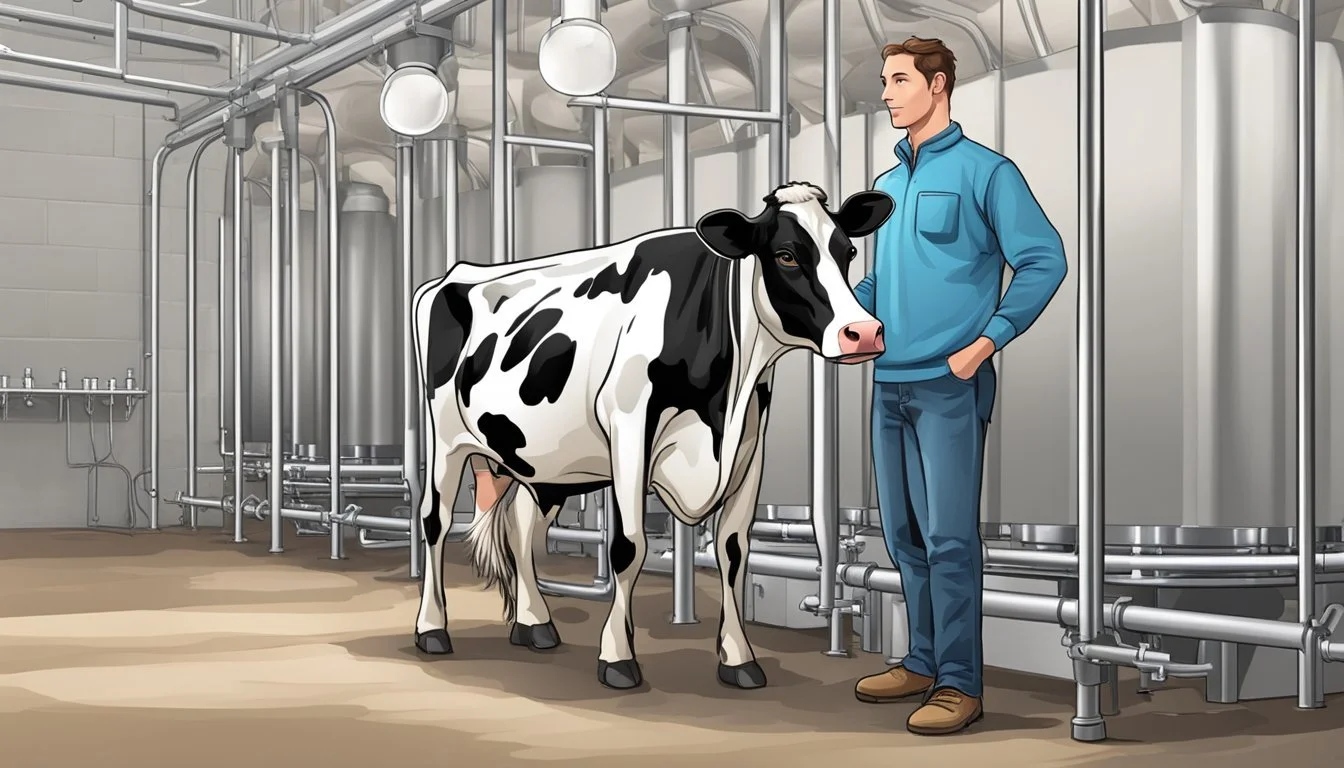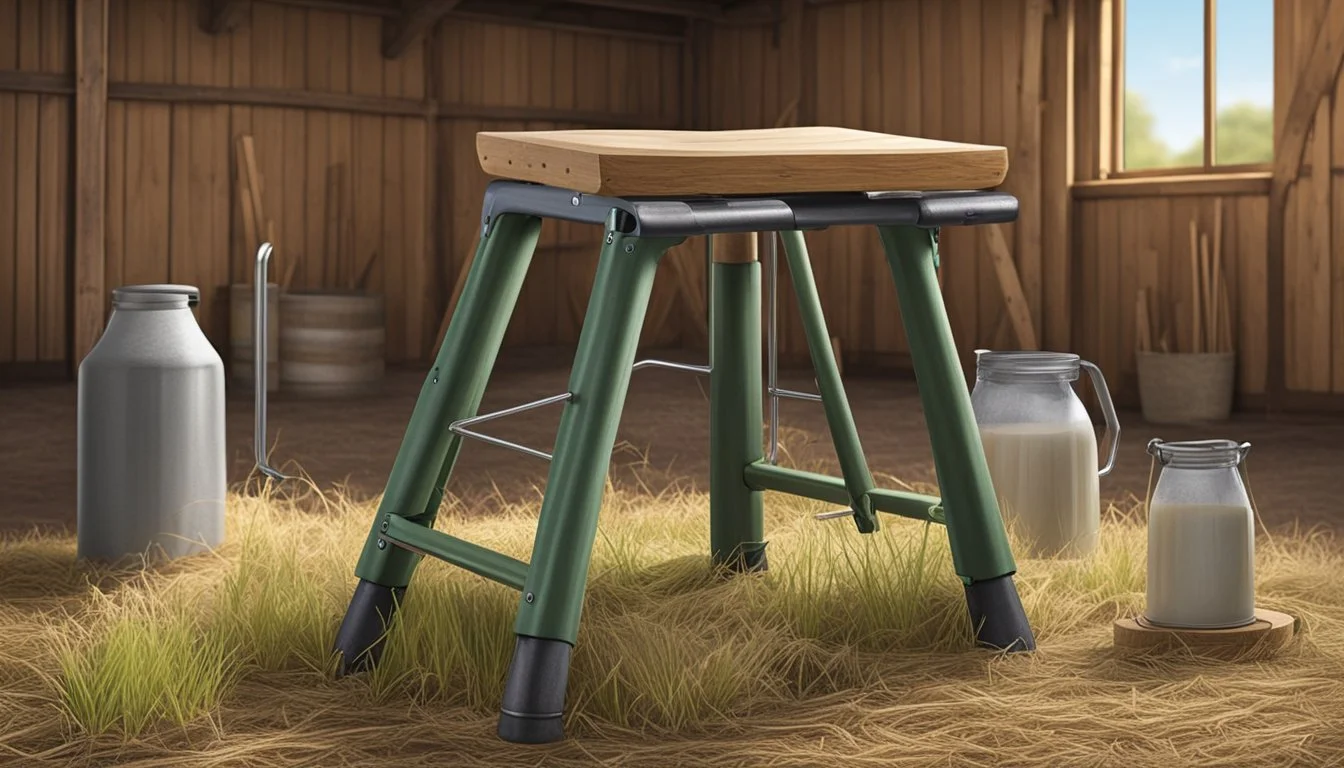The Ultimate Guide to Choosing a Portable Milking Stool
Comfort and Convenience for Homestead Hand Milking
Selecting the right portable milking stool is crucial for anyone engaged in hand milking on their homestead. This choice not only impacts the efficiency and ease of milking but also the comfort and health of the person milking. A suitable stool allows the milker to be at the right height in relation to the animal, ensures stability, and can even assist in reducing the physical strain that comes with milking by hand.
Homesteaders must consider several factors when choosing a milking stool, including durability, design, and comfort level. Features such as adjustable straps, a sturdy build, and an ergonomic design can greatly enhance the milking experience. Properly selected, a milking stool becomes an invaluable tool that contributes to cleaner milking practices and can even have a positive effect on milk production by keeping the animals calm and comfortable during the process.
The Importance of a Good Milking Stool
Choosing a sturdy milking stool is critical for any homesteader who hand-milks livestock. The right stool offers a stable base, which means less energy spent maintaining balance and more focused on the task of milking.
Comfort is paramount when it comes to hand milking. A well-designed stool should support the milker's posture, preventing backache and fatigue. A comfortable seat can also positively impact the demeanor of the livestock, as a relaxed handler often leads to a calmer animal.
A milking stool isn't just a sitting apparatus; it's a tool that contributes to the efficiency of milking. A stool with adjustable height ensures that the milker can reach the udders without strain, optimizing milk letdown and maintaining hygiene.
Here's a breakdown of key attributes in a durable milking stool:
Stability: A three-legged design or stool with a wide base offers stability on uneven barn floors.
Material: Materials should be easy to clean, preventing the buildup of bacteria and odors.
Mobility: Portability is essential; a lightweight stool allows it to be moved with ease.
Adjustability: The ability to adjust the stool height caters to different user and animal sizes.
The right stool becomes an extension of the milker's toolkit, seamlessly integrating into the daily routine and contributing to a productive and enjoyable milking experience.
Factors to Consider When Choosing a Milking Stool
Selecting the right milking stool is crucial for efficiency and comfort during hand milking. This guide will focus on essential attributes, such as the stool's height, material, adjustability, and safety features, to aid homesteaders in making an informed decision.
Stool Height and Comfort
The height of a milking stool is paramount to ensure comfort during milking. An optimal stool height allows the milker to sit close enough to the animal without stooping, preventing backaches. The seat's comfort is also critical; materials like sturdy co-polymer can provide a contoured surface that is both comfortable and durable.
Stool Design and Materials
A good milking stool should be characterized by high-quality materials that provide both functionality and longevity. Sturdy co-polymers or hardwoods are excellent materials choices, offering resilience and easy cleaning. Some stools may come with a backrest or a pedestal leg design, which can contribute to the user's comfort and the stool's aesthetic appeal.
Adjustability and Portability
Adjustable straps or a coil spring mechanism can make a stool more ergonomic, allowing height adjustments to fit individual user needs. A portable milking stool with a handle, light in weight, and compact design can be moved easily, making it a versatile tool for different locations around the homestead.
Stability and Safety Features
When it comes to safety, stability is non-negotiable. A milk stool should have a firm anti-slip base or three-legged configuration to prevent tipping over. Some stools are equipped with snap-on locks to keep them in place and additional safety features like anti-slip coatings on the legs to enhance security during milking sessions.
Enhancing the Hand Milking Process
To improve efficiency and ensure cleanliness during hand milking, it is essential to have a thorough routine, from preparation to milk storage. Each step of the process contributes to a comfortable experience for both the milker and the cow, as well as the quality of the milk produced.
Preparation and Cleaning
Proper preparation is vital for a smooth milking session. Before milking, prep the udders by cleaning them with a mild, disinfectant solution to prevent contamination and maintain hygiene. Ensure your own hand cleanliness with thorough washing to prevent any bacterial transfer.
Udder Cleaning Protocol:
Clean udder and teats with a sanitizing solution.
Dry with a clean towel.
Efficient Milking Techniques
Efficient hand milking techniques prevent injury to the cow's udder and speed up the milking process. Use consistent hand positions: encircle the base of the teat with the thumb and forefinger to trap the milk, and then squeeze the teat with the remaining fingers.
Milking Steps:
Trap the milk.
Squeeze the teat consistently.
Repeat and alternate hands rhythmically.
Utilizing Appropriate Equipment
Employ durable, stainless steel buckets for collection because they are easy to clean and maintain. For comfort, utilize a stable milking stool to support your posture. Effectively position the milk bucket to avoid being kicked, saving time and avoiding milk contamination.
Equipment Checklist:
Stainless steel milking bucket
Stable milking stool
Milk Storage and Transfer
After milking, immediately transfer the fresh milk to a cooling facility to preserve its quality. Use clean two buckets to ensure there is enough space for all the milk and prevent overfilling, which could lead to spills and waste.
Post-Milking Routine:
Transfer milk to pre-chilled containers.
Store in a cool place swiftly.
Caring for the Dairy Cow
When it comes to the well-being of dairy cows, proper health maintenance and comfort during milking are paramount. This ensures optimal milk production and a stress-free environment that benefits both the cow and the farmer.
Health Considerations
Dairy cows require consistent monitoring to prevent diseases such as mastitis, an infection of the udder that can impede milk flow. Mastitis is often indicated by changes in the milk such as a watery appearance, flakes, or clots. Early detection and treatment are crucial, as this condition can cause discomfort to the cow and lead to reduced milk production. A clean and warm environment helps maintain udder health and allows for the natural release of oxytocin, which stimulates milk flow.
Regular Health Checks: Include examination of teats and udder for signs of swelling or infection.
Udder Hygiene: Clean the udder with mild disinfectant before and after milking to prevent bacterial infections.
Veterinary Care: Immediate attention from a veterinarian when signs of infection or ill health are present.
Cow Positioning and Stanchion Use
The use of a stanchion ensures that the cow remains still during milking, reducing the risk of kicking and potential injury to both the cow and farmer. A proper stanchion setup is:
Sturdy and Comfortable: It should be strong enough to hold the cow securely without causing discomfort.
Correctly Sized: The stanchion must be the right size for the animal to avoid undue stress or the potential of slipping.
Positioning the cow correctly and using a milk stool that provides comfort for the farmer can make the process stress-free. Factors to consider for proper cow positioning include:
Avoid Tying Too Tightly: To prevent causing stress or discomfort to the cow.
Milk Stool Height: Ensure the milk stool is at an appropriate height for the farmer, promoting good posture and comfort during milking.
Calf Management
Proper calf management plays a critical role in a stress-free milking routine. Calves should be allowed adequate time to feed from their mother before milking, which can also stimulate milk production. Best practices include:
Scheduled Feeding: Allowing calves to stimulate the cow's milk production through natural feeding behavior.
Separation Timing: Knowing when to separate the calf from the mother to balance natural feeding with milk collection.
Comparison of Traditional and Contemporary Stools
When selecting a milking stool, comfort and functionality should drive the decision. Traditional and contemporary stools offer diverse benefits tailored for hand milking.
Classic Wooden Stools Versus Modern Designs
Traditional milking stools, often crafted from wood, provide a sturdy base with a simple design. They typically feature three legs, giving stability on uneven surfaces found in many homestead environments. These classic stools are commonly without backs, promoting an upright posture during milking.
Traditional Wooden Milking Stool
Handcrafted, warm aesthetic
No backrest
Fixed height
Contemporary Milking Stool
Sleek, modern look
Optional backrest for comfort
Adjustable height for versatility
Contemporary stools introduce a modern twist with innovative materials like co-polymers, offering enhanced durability. The design may include molded-in holes for carrying, and some have adjustable legs or seats to accommodate different users. These features can significantly improve milker comfort, which is crucial during prolonged periods of use.
Advantages of Innovative Features
Contemporary milking stools offer advantages in comfort and functionality. Their modern materials, such as sturdy co-polymers, ensure longevity and resistance to the wear and tear of daily farm use. The option for a backrest supports good posture, which can reduce fatigue and muscle strain.
Sturdy co-polymer materials
Resists damage
Easy to clean
Lightweight
Adjustable height
Customizes to user and animal for optimal positioning
Backrest
Provides support
Enhances comfort during long milking sessions
Milkers with physical constraints may find the adjustable features of modern designs particularly beneficial, as they provide the flexibility to alter the stool for their specific needs. The integration of ergonomic considerations in contemporary stool designs can significantly boost comfort and milk-harvesting efficiency on the homestead.
Product Reviews and Recommendations
When selecting a portable milking stool, comfort and sturdiness are key considerations. Farmers need tools that will reduce physical strain and increase efficiency during milking.
Strap-On Milking Stool: This stool features a co-polymer seat designed for durability and holes for harness strap adjustment. The sturdy, soft nylon harness locks in place, claiming to reduce backaches and save time.
Mapotad 7L Electric Goat Milking Machine: As part of a broader milking machine, the associated stool component is lauded for being optimal for battery-powered operations. Despite higher prices, the ratings suggest it offers quality in line with its cost.
Strap-On Milking Stool
Comfort Features: Adjustable straps, nylon harness
Sturdiness: Sturdy co-polymer seat
User Ratings: Not Specified
Mapotad 7L Electric
Comfort Features: Part of milking machine setup
Sturdiness: Integral to machine's build
User Ratings: High
A less tech-centric option comes from Foter, offering a traditional hardwood milking stool. Its simplistic design speaks to a charming, handcrafted ethos and a reinforced 3-legged base promising stability.
For consumers seeking both portability and ease-of-setup, Hantop Milking Machine boasts that its stools can be assembled in around 15 seconds, facilitating easy use for both cow and goat milking.
When investing in a milking stool, farmers should consider how a product's design and features will contribute to a more comfortable and labor-saving milking process. Each product presents a balance of comfort-enhacing features and practical sturdiness, without exaggerated or unsubstantiated claims.
Maintenance and Longevity of Milking Stools
Proper maintenance is crucial for ensuring the longevity of a milking stool. They should regularly inspect their stool for any signs of wear or damage, particularly before use. A sturdy milking stool not only provides comfort but also stability during the milking process.
Materials matter when it comes to durability. Milking stools made of high-quality wood, such as elm or ash, are known for their resilience. They must treat them with appropriate wood sealants to protect against moisture, which is inevitable in a milking environment.
Routine Checks: They should examine all legs and joints for stability.
Cleaning: After use, they should clean the stool to remove dirt and debris.
Storage: Store the stool in a dry place to prevent wood rot or metal corrosion.
For portable milking stools with adjustable features or harness systems, owners should ensure that:
All moving parts function smoothly.
The harness material is free of tears and excessive wear.
The height adjustment mechanism remains easy to operate and firm in the chosen position.
Table of Essential Maintenance Tools and Supplies
Soft Cloth
Purpose: For cleaning surfaces
Wood Sealant
Purpose: To protect wood components
Screwdriver
Purpose: To tighten any loose screws
Replacement Kit
Purpose: For worn out parts like harnesses
Remember, maintaining a milking stool is not just about preserving a functional farm tool; it's about ensuring the milker's comfort and the efficiency of their milking routine. Regular upkeep helps extend the stool's service life, offering reliable support in daily farm activities.
Purchasing Tips and Considerations
When selecting a portable milking stool, comfort, sturdiness, and the ability to adjust are crucial for efficiency and the wellbeing of the user. Knowing where to buy, understanding product descriptions, and handling shipping are key to making a well-informed purchase.
Where to Buy Quality Milking Stools
Quality milking stools can be found both online and in physical farm supply stores. When shopping online, look for reputable platforms that specialize in farm equipment or general e-commerce sites with high customer ratings. Farming communities may also share information about upcoming easter sales and couple codes, which can be used to get discounts on tools like milking stools.
Online Farm Suppliers: Specialized shops with a broad range of agricultural tools.
Local Farm Stores: Personalized service and the benefit of supporting local businesses.
E-commerce Giants: Often have a wide variety at competitive prices, with multiple seller options.
Decoding Product Descriptions
The product descriptions should be read carefully to ensure the stool is adjustable, portable, and sturdy. Look for specific terms that guarantee comfort, like 'ergonomically designed', and materials that denote sturdiness such as 'stainless steel construction'. Check if the stool can be adjusted to different heights, as this will cater to different users and cow sizes.
Materials: Stainless steel, wood, reinforced plastic.
Comfort Indicators: 'Padded seat', 'ergonomic design'.
Adjustability: Terms like 'height-adjustable', 'multi-level settings'.
Handling Shipping and Delivery
Consider the shipping and delivery policies when purchasing a milking stool online. Check for lead time, delivery costs, and return policies in case the product does not meet expectations. Some sellers may offer free shipping during special promotions or for a minimum purchase amount.
Lead Time: Understand estimated shipping times to plan accordingly.
Delivery Costs: Factor these into the total purchase price.
Return Policies: Look for options offering free returns or exchanges to mitigate risk.
Conclusion
Selecting the right portable milking stool is crucial for the comfort and efficiency of hand milking on any homestead. A well-chosen stool not only supports proper posture but also eases the physical strain associated with daily milking routines. When making a decision, consider the following essentials:
Stability: A stool with a sturdy design prevents tipping.
Comfort: Cushioned seats can significantly enhance comfort during long milking sessions.
Height: An appropriate stool height aligns with the milker's body size and the cow's anatomy.
Material: Durable materials like wood or metal ensure longevity.
Homesteaders should also weigh the portability of the stool. Lighter stools are easily moved, yet they must be heavy enough to offer stability. In addition to the physical aspects, style and sustainability may influence the decision, with many opting for stools crafted from renewable resources to align with homesteading values.
Ultimately, the choice of a milking stool should reflect both the functional needs of the milker and the well-being of the cows. A thoughtful investment in the right milking stool pays off in the form of enhanced milking experience.









